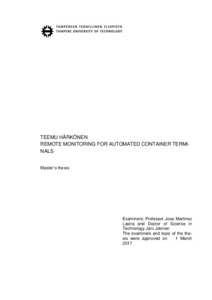Remote monitoring for automated container terminals
Härkönen, Teemu (2017)
Härkönen, Teemu
2017
Automaatiotekniikan koulutusohjelma
Teknisten tieteiden tiedekunta - Faculty of Engineering Sciences
This publication is copyrighted. You may download, display and print it for Your own personal use. Commercial use is prohibited.
Hyväksymispäivämäärä
2017-03-08
Julkaisun pysyvä osoite on
https://urn.fi/URN:NBN:fi:tty-201702131114
https://urn.fi/URN:NBN:fi:tty-201702131114
Tiivistelmä
This master’s thesis studies the possibilities of remote connections and remote monitoring for the cargo handling solution provider Kalmar. Kalmar’s equipment is used in critical container terminals, where downtimes or delays are not tolerated, which is why it is important to provide reliable machines. This thesis studies, whether monitoring data could help in creating more reliable machines, and how different stakeholders could benefit from remote monitoring. During this master’s thesis work, a demo version of a remote center was built at Kalmar’s Tampere Competence Center. New telecommunication technologies, such as URLLC and LoRa, which may prove to be helpful in establishing wireless remote connections in container terminals, are also discussed in the case study.
The theoretical part of this study mainly consists of a literature review, focusing on remote connections and monitoring, Industrial IoT (Evans, Annunziata 2012, Kunttu, Kiiveri 2012, Jurvansuu, Ailisto et al. 2013), data visualization (Becker, Mottay 2001, Väänänen-Vainio-Mattila, Wäljas 2009) and maintenance (de Faria Jr., Costa et al. 2015, Peng, van Houtum 2016). The case study of the thesis is based on literature studies and empirical data. The empirical data was collected by participating in Kalmar’s development events and by building a demo version of the remote center. First-hand observation on Kalmar’s products and operations was done during a summer internship and in informal discussions with Kalmar’s engineers and managers.
This thesis suggests that remote connections and remote monitoring would benefit Kalmar and other stakeholders involved. A physical remote center is not necessarily needed in order to monitor equipment globally, but it could have significant marketing value. Wireless communication technologies related to remote connections and monitoring could offer more flexible deployment of cranes and cost savings. It seems that remote connections and monitoring could provide a lot of new business possibilities for Kalmar.
The theoretical part of this study mainly consists of a literature review, focusing on remote connections and monitoring, Industrial IoT (Evans, Annunziata 2012, Kunttu, Kiiveri 2012, Jurvansuu, Ailisto et al. 2013), data visualization (Becker, Mottay 2001, Väänänen-Vainio-Mattila, Wäljas 2009) and maintenance (de Faria Jr., Costa et al. 2015, Peng, van Houtum 2016). The case study of the thesis is based on literature studies and empirical data. The empirical data was collected by participating in Kalmar’s development events and by building a demo version of the remote center. First-hand observation on Kalmar’s products and operations was done during a summer internship and in informal discussions with Kalmar’s engineers and managers.
This thesis suggests that remote connections and remote monitoring would benefit Kalmar and other stakeholders involved. A physical remote center is not necessarily needed in order to monitor equipment globally, but it could have significant marketing value. Wireless communication technologies related to remote connections and monitoring could offer more flexible deployment of cranes and cost savings. It seems that remote connections and monitoring could provide a lot of new business possibilities for Kalmar.
